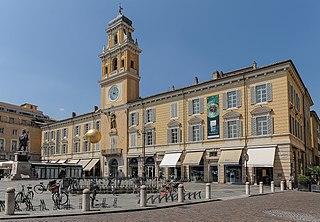
Parma is a city in the northern Italian region of Emilia-Romagna known for its architecture, music, art, prosciutto (ham), cheese and surrounding countryside. With a population of 198,292 inhabitants, Parma is the second most populous city in Emilia-Romagna after Bologna, the region's capital. The city is home to the University of Parma, one of the oldest universities in the world. Parma is divided into two parts by the stream of the same name. The district on the west side of the river is Oltretorrente. Parma's Etruscan name was adapted by Romans to describe the round shield called Parma.

Pier Luigi Farnese was the first Duke of Castro from 1537 to 1545 and the first Duke of Parma and Piacenza from 1545 to 1547. He was the illegitimate son of Cardinal Alessandro Farnese. He became a soldier and participated in the sack of Rome in 1527.

Ranuccio I Farnese reigned as Duke of Parma, Piacenza and Castro from 1592. A firm believer in absolute monarchy, Ranuccio, in 1594, centralised the administration of Parma and Piacenza, thus rescinding the nobles' hitherto vast prerogative.

The House of Farnese was an influential family in Renaissance Italy. The titles of Duke of Parma and Piacenza, Duke of Latera and Duke of Castro were held by various members of the family.

Colorno is a comune (municipality) in the Province of Parma in the Italian region Emilia-Romagna, located about 90 kilometres (56 mi) northwest of Bologna and about 15 kilometres (9 mi) north of Parma.

The Ducal Palace, also known as Reggia di Colorno, is an edifice in the territory of Colorno, Emilia Romagna, Italy. The palace we see today was refurbished by Francesco Farnese, Duke of Parma in the early 18th century on the remains of a former castle.
The County of Montechiarugolo was a small sovereign state of northern Italy which existed from 1456 to 1612. It included the other fief of Casei.

The Shrine of Santa Maria della Steccata is a Greek-cross design Renaissance church in central Parma, Italy. The name derives from the fence in the church. A Nursing Madonna is enshrined within, crowned on 27 May 1601 by a Marian devotee, Fray Giacomo di Forli of the Capuchin order. Pope Benedict XVI raised the Marian sanctuary to the status of Basilica minor on 9 February 2008.

The Val di Taro is the valley of the Taro river, a tributary of the Po. The valley lies almost entirely in the Province of Parma, in the Emilia-Romagna region of Italy.

Margherita Aldobrandini, was an Italian noblewoman member of the Aldobrandini family and by marriage Duchess consort of Parma and Piacenza during 1600–1622. She was also Regent of both Duchies during 1626–1628 on behalf of her minor son.
Ottavio Farnese was an Italian nobleman of the House of Farnese, which ruled the Duchy of Parma from 1545 to 1731.

Pomponio Torelli was Count of Montechiarugolo and a writer of prose, poetry and plays. He is principally remembered for his five tragedies.

The Landi were a noble family from Piacenza, in northern Italy. From 1551 to 1582, they were princes of the Val di Taro, now in the province of Parma, at that time in papal territory. Their principality is sometimes called Lo Stato Landi ; although the term is not well known, there is substantial documentation of it in the Archivio Segreto Vaticano, in the Vatican City.
Troilo I de' Rossi was an Italian condottiero and the first marquess of San Secondo.

Portrait of Pier Luigi Farnese is a heavily-damaged 1546 oil on canvas painting of Pier Luigi Farnese, Duke of Parma by Titian, now in Room 2 of the National Museum of Capodimonte.
Sanvitale is an Italian surname. It may refer to:

The Palazzo del Giardino or Palazzo Ducale del Giardino is a historic palace in the Parco Ducale in Parma. It is not to be confused with the official Parma residence of Marie Louise, Duchess of Parma between Palazzo della Pilotta and Palazzo della Provincia in what is now known as piazzale della Pace - she also lived at the Ducal Palace of Colorno and in the Casino dei Boschi in Sala Baganza. The main Ducal Palace in Parma, the Palazzo della Pilotta and the Reinach Theater were all destroyed in an early morning air raid on 13 May 1944, carried out by the 465th Heavy Bombardment Group of the US Airforce, 781st Squadron, which dropped 9 GP bombs on the city centre.

Barbara Sanseverino was an Italian noblewoman.

The Rocca Sanvitale or Sanvitale Castle of Sala Baganza is a fortress/palatial residence located on Piazza Gramsci #1, overlooking the small town of Sala Baganza, just southwest of Parma, region of Emilia-Romagna, Italy. It is distinct from the more-visited moated castle of Rocca Sanvitale, Fontanellato.

The Ducal Palace of Parma was a neoclassical palace in Parma, Italy. It was located on the west side of the Piazzale della Pace. Between its construction and 1859, it was the residence of the Dukes of Parma. After 1859, it became the prefecture.















